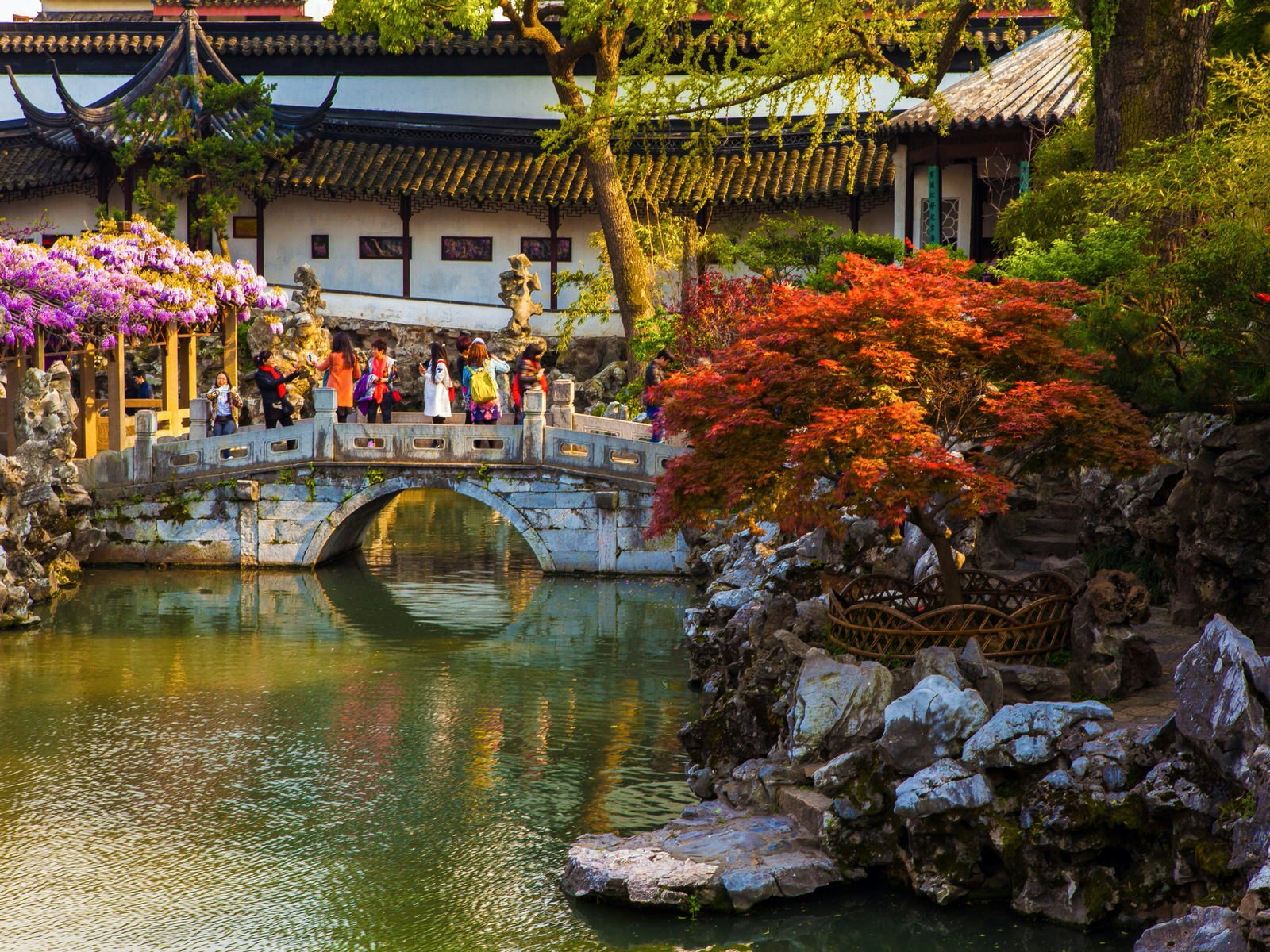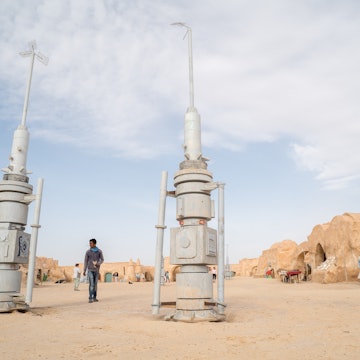
Garden to linger in: Suzhou's elegant classical Chinese gardens
Mar 27, 2018 • 6 min read

A round moon gate surrounded by white walls and green trees in Suzhou's most famous garden, the Humble Administrator's Garden © Zharov Pavel / Shutterstock
As well as being known as the ‘Venice of the East’, thanks to its network of picturesque canals, the elegant city of Suzhou on China's eastern seaboard is also famed for its classical gardens.
There are currently 69 gardens preserved in Suzhou, with nine designated as a Unesco World Heritage Site. But what makes Suzhou’s gardens so special? And what should we look out for when we visit them?

Suzhou's fertile history
Nestled in the lower reaches of the Yangzi River, on the shores of Lake Tai – one of China’s largest freshwater lakes – Suzhou has long benefited from the fertile lands that surround it and the social stability they have supported.
The city we now know as Suzhou was founded in 514BC as the capital of the-then state of Wu. Leaders took advantage of Suzhou’s natural environment, building elegant royal residences and game parks, and the royal court prospered thanks to the rich fishing and rice cultivation on the Yangzi Delta.

In the early 5th century BC, the Wu state fell and King Helü died and was buried at Tiger Hill, still in existence today. The royal gardens fell into disrepair as new leaders came into power, although some were turned into ordinary gardens, laying the foundations for the development of the private gardens we see today.
By the end of the first century AD, Suzhou had become one of the world’s largest cities and a boom in religious practice saw a rise in temple-style gardens. Built by religious scholars as rural retreats, these gardens reflected Suzhou's natural beauty and strongly influenced the art of garden design.

Suzhou flourished in the intervening millennia, and wealthy families with their long-term ambitions made homes here. When the Grand Canal was completed during the Sui dynasty (581–618), Suzhou found itself strategically located on a major trade route, and during the Tang dynasty (618–907) , the city became a haven for poets, academics and rich merchants.
Suzhou has long been stable and wealthy enough to support the pursuit of aesthetic projects. The local people showed the outside world their appreciation for beauty and culture through the gardens, and that they had the time and money to build these beautiful landscapes.
Havens for intellectuals
During the Ming (1368–1644) and Qing (1644–1911) dynasties, affluent scholars, poets and artists moved to the area, creating a vibrant arts and literary scene. Their secluded and impeccably landscaped walled-off residence compounds provided peaceful retreats from the city's heaving streets and canals.

Constructing and constantly improving their gardens became a way for socially established families to compete with their neighbours, building ever more elaborate features, and discussing and developing the art and theory of landscape architecture. It’s claimed that during the height of garden construction, there were more than 200 private gardens filling half of the area within Suzhou's city walls.
Gardens were not only a way for their owners to demonstrate their standing in life, but also a space to show off their impeccable academicism. Gardens were decorated with famous works of art, literary inscriptions and monumental steles to create an intellectually rich atmosphere. Many exquisite examples of these can be seen at the Garden to Linger In.

Owners of the gardens were often retired government officials escaping political life. In 1510, when imperial envoy Wang Xianchen retired here, he set about building a garden in which to de-stress from his tumultuous official career. That garden became Suzhou’s most famous attraction, the Humble Administrator's Garden.
Gardens were also used as places for discussing the important topics of the day. The Garden of Cultivation, for example, was owned by Jiang Cai, a Ming-dynasty scholar and minister of foreign affairs, who used it as a place for intellectuals to gather and discuss politics.

Surviving turbulent times
Twentieth-century China was an altogether more difficult place for Suzhou's gardens to flourish, with upheavals during the Taiping Rebellion (a civil war that waged from 1850–1864), World War II and the birth of the new republic in 1949, and subsequent Cultural Revolution. Many gardens were removed from private ownership, destroyed or damaged. Some, like the Humble Administrator’s Garden and the Garden of the Master of the Nets, were restored in the 1950s, while others lay ruined for years.
In the 1980s, as China opened to a burgeoning tourism industry, the gardens were once again considered integral to the country's cultural heritage. Gardens that needed it were renovated and opened to the public.

Despite the trials and tribulations of the last 2500 years, Suzhou’s gardens have endured as symbols of a city that has long seen itself as a centre of culture, beauty and civilisation. They are once again places of peaceful contemplation, now serving as refuges in a country that continues its break-neck development. And in 1997, the gardens were collectively listed as a World Heritage Site by Unesco.
Elements of a classical Chinese garden
Suzhou’s gardens are considered classic examples of Chinese landscape architecture. They were intended to be microcosms of the natural world, with rich scenes within limited spaces. Miniature versions of things like rocks and trees create epic-looking landscapes in the tightest of corners. The Blue Wave Pavilion is a good example of the illusion of huge seas and mountains at garden-sized scale.

Moving through a garden, views should change at every step, in the manner of traditional Chinese scroll paintings, which unfurl in a continuous narrative. Surprises should await around every corner, the garden only revealing its secrets the longer, and more slowly, you wander through it. Walls, doors, windows, paths, corridors, and bridges create this continuous change, while carefully engineered windows and dramatic moon gates allow spectacular views. Both the Humble Administrator’s Garden and the Garden to Linger In use moon gates to Instagram-worthy effect.

Gardens should reflect art, specifically classical landscape painting, and the white-washed walls and black eaves that surround them serve to set off the elements within. These lean heavily on natural materials like water, rockeries and plants, to create balance.
Artificial structures like pavilions and covered corridors allow for the enjoyment of the garden in any weather. The roofed walkway in the Lion Grove Garden, for example, allows you to see its fantastical rock formations all year round.

The intimate beauty of the gardens is revealed in intricate details, such as imaginatively patterned pebble footpaths, often depicting squares within circles and reflecting the ancient Chinese belief that 'heaven is round and the earth square'. Figures of good fortune can be found hidden throughout, including carved bats and cranes, which symbolise prosperity and longevity. At the Couple’s Garden, many elements are built in pairs, representing a couple’s love for each other.
Make it happen
Suzhou is located in Jiangsu province on China's eastern seaboard. High-speed trains connect the city to Shanghai in about 30 minutes.
Before visiting the gardens, be sure to check out the Suzhou Garden Museum, a free museum that details the history and cultural significance of the gardens.

All of Suzhou's gardens are worth visiting, but to truly appreciate their intended tranquillity, try to visit the smaller, less famous gardens. Going on a weekday allows you to avoid large tour groups that trudge through the more well-known gardens. Visitors often overlook smaller gardens, such as the Garden of Harmony, but these offer a quieter and altogether more mentally soothing introduction to Suzhou’s classical gardens.













